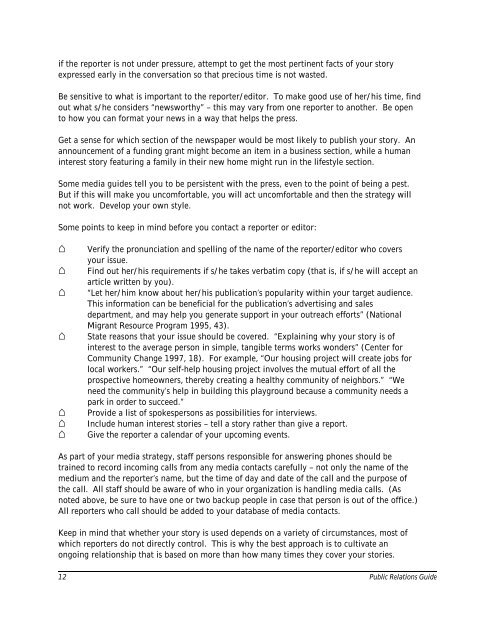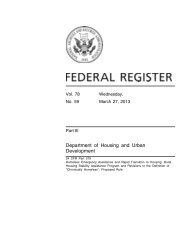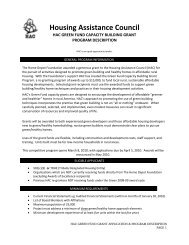Public Relations Guide for Rural Housing Organizations (manual
Public Relations Guide for Rural Housing Organizations (manual
Public Relations Guide for Rural Housing Organizations (manual
Create successful ePaper yourself
Turn your PDF publications into a flip-book with our unique Google optimized e-Paper software.
if the reporter is not under pressure, attempt to get the most pertinent facts of your storyexpressed early in the conversation so that precious time is not wasted.Be sensitive to what is important to the reporter/editor. To make good use of her/his time, findout what s/he considers “newsworthy” – this may vary from one reporter to another. Be opento how you can <strong>for</strong>mat your news in a way that helps the press.Get a sense <strong>for</strong> which section of the newspaper would be most likely to publish your story. Anannouncement of a funding grant might become an item in a business section, while a humaninterest story featuring a family in their new home might run in the lifestyle section.Some media guides tell you to be persistent with the press, even to the point of being a pest.But if this will make you uncom<strong>for</strong>table, you will act uncom<strong>for</strong>table and then the strategy willnot work. Develop your own style.Some points to keep in mind be<strong>for</strong>e you contact a reporter or editor:- Verify the pronunciation and spelling of the name of the reporter/editor who coversyour issue.- Find out her/his requirements if s/he takes verbatim copy (that is, if s/he will accept anarticle written by you).- “Let her/him know about her/his publication’s popularity within your target audience.This in<strong>for</strong>mation can be beneficial <strong>for</strong> the publication’s advertising and salesdepartment, and may help you generate support in your outreach ef<strong>for</strong>ts” (NationalMigrant Resource Program 1995, 43).- State reasons that your issue should be covered. “Explaining why your story is ofinterest to the average person in simple, tangible terms works wonders” (Center <strong>for</strong>Community Change 1997, 18). For example, “Our housing project will create jobs <strong>for</strong>local workers.” “Our self-help housing project involves the mutual ef<strong>for</strong>t of all theprospective homeowners, thereby creating a healthy community of neighbors.” “Weneed the community’s help in building this playground because a community needs apark in order to succeed.”- Provide a list of spokespersons as possibilities <strong>for</strong> interviews.- Include human interest stories – tell a story rather than give a report.- Give the reporter a calendar of your upcoming events.As part of your media strategy, staff persons responsible <strong>for</strong> answering phones should betrained to record incoming calls from any media contacts carefully – not only the name of themedium and the reporter’s name, but the time of day and date of the call and the purpose ofthe call. All staff should be aware of who in your organization is handling media calls. (Asnoted above, be sure to have one or two backup people in case that person is out of the office.)All reporters who call should be added to your database of media contacts.Keep in mind that whether your story is used depends on a variety of circumstances, most ofwhich reporters do not directly control. This is why the best approach is to cultivate anongoing relationship that is based on more than how many times they cover your stories.12 <strong>Public</strong> <strong>Relations</strong> <strong>Guide</strong>









